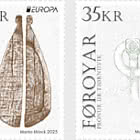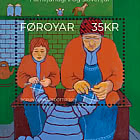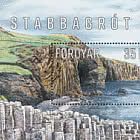The first faroese book – 200th Anniversary
The first book in Faroese 1822. H.C. Lyngbye: »Føröiske Qvæder om Sigurd Fofnersbane og hans Ætt«.
The first book in the Faroese language was printed in 1822 when H.C. Lyngbye published "Faroese Heroic Ballads of Sigurd, the Slayer of the Dragon Fafnir and His Kindred". The text was a transcript of a ballad derived from the extensive Faroese oral tradition, where songs are performed by a lead singer in a closed chain of dancers chanting along to the chorus. This Faroese chain dance is a combination of narratives, melodies and bodily expressions, where the lead singer through dramatic interaction with the dancers chants the main lyrics.
The early 1800s saw a growing antiquarian interest among the scholarly elite in the traditions of the common people. Songs and folktales were written down, edited, published and often became the basis for stringent academic studies that were far removed from the colourful folk traditions. Nevertheless, these texts later became crucial to Faroese identity and the main reason for the ancient Faroese chain dance tradition being alive today.
Lyngbye's sensational discovery
H.C. Lyngbye, who came from Østhimmerland in Denmark, was a newly trained priest from Copenhagen and also a classicist and natural scientist with an interest in botany. This led him on a scientific journey to the Faroe Islands in 1817, where he mainly studied seaweed, but also collected a lot of other Faroese material.
In keeping with his antiquarian and linguistic interest, he noted down parts of the extensive oral Faroese ballad tradition, among them 164 quatrains chanted by an old man in Thorshavn. On his return to Copenhagen, Lyngbye showed these quatrains to the theologian and ballad researcher P.E. Müller, who was surprised and excited to find that motifs in the poems had its origins in the famous Nibelungenlied, Edda poetry and Völsungasaga, the Saga of the Volsungs.
It became quite a sensation that parts of this renowned circle of legends had been handed down orally through the ages in the Faroe Islands. In order to collect the bulk of the ballad of Sigurd the Dragon Slayer, Müller and Lyngbye approached the Faroese pastor J.H. Schrøter in Hvalba, whom Lyngbye had visited on his earlier trips to the islands.
First edition in Faroese
In the following year, Schrøter collected the bulk of the poem and in 1819 he sent all the quatrains to Lyngbye, who prepared and arranged all the material in the years that followed.
At this time, there was no standard for the orthography of written Faroese, so H.C. Lyngbye in his manuscript used the orthography adapted by the great Faroese scholar J. Chr. Svabo during his stay in the Faroe Islands in 1817. The Faroese quatrains were accompanied by Lyngbye's Danish translation throughout the 592-page book with a preface by Lyngbye and an introduction by P.E. Müller. Towards the back of the book there is a sheet of music with notes of the original melody. The publication was supported by the Danish king's "Fonden ad usus publicos" – Fund for Public Use.
The beginnings of Faroese nation building
At this time, nationalistic ideas were spreading in intellectual and scholarly circles in Europe. These ideas emphasized tradition, national language and character as the basis of national identity, national borders and ultimately political power. Therefore, it was essential to find and write down songs and ballads, legends and other folklore that had been orally handed down to the common folks from generation to generation.
The Faroese book of ballads was reviewed in 1824 by the famous philologist and folklorist Wilhelm Grimm. He was known throughout Europe as a central figure in anthropology and peasant folklore research, which was deemed essential to nation-building in Germany. Grimm's review had the effect that in the following years Nordic and European schoolchildren became more interested in the Faroese cultural expressions. The publication of the book also popularized the idea of collecting hymns and ballads locally in the Faroe Islands.
By writing down the oral traditions, publishing it in Faroese and thus reaching larger audiences, attention was drawn to the texts of the Faroese ballad tradition. It also raised an incipient understanding that Faroese could be considered an independent language.
The beginnings of Faroese literature
H.C. Lyngbye's publication in 1822 therefore marks a milestone in the steady progress of the Faroese nation by attracting increased domestic and inter-European interest in Faroese culture and by emphasizing the need to construct a Faroese written language. This was done in 1846, becoming the first criterion for the extensive Faroese literature that has since been published. Thus, Lyngbye’s publication had fundamental significance for the present perception of Faroese national identity where the Faroese language constitutes an essential foundation of Faroese culture and society.
The first Faroese book souvenir sheet
The stamp issue celebrating the 200th anniversary of the first Faroese publication consists of a souvenir sheet with two stamps. The KR29 stamp on the left is based on the ballad of Sigurd and depicts a chain of dancers swaying to the dramatic dragon ballad with the sheet music in the background.
On the second stamp KR43, the chain dancers chant the chorus next to the title page of the orignal publication. This illustrates the dramatic ballad tradition which is being simplified as a text in a book. J.H. Schrøter's original manuscript for the book is seen in the background. The stamp issue was designed and arrranged by visual artist and historian Ole Wich.









































